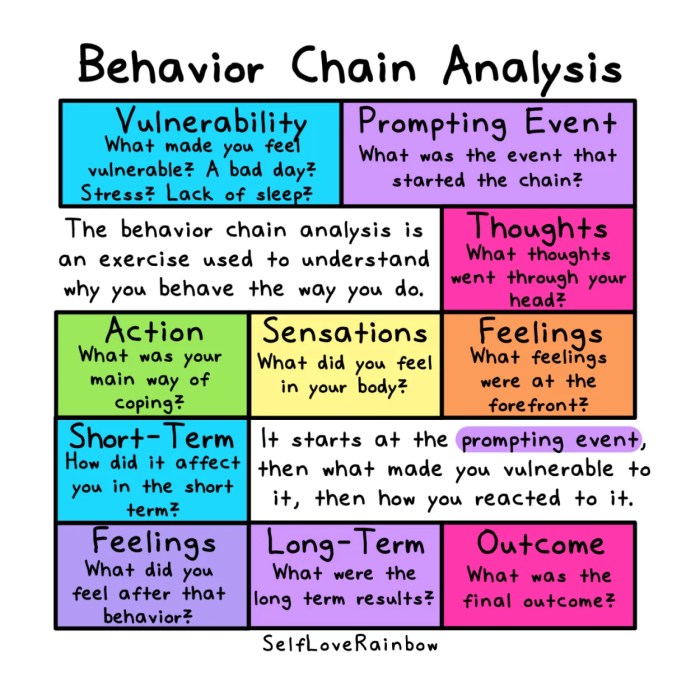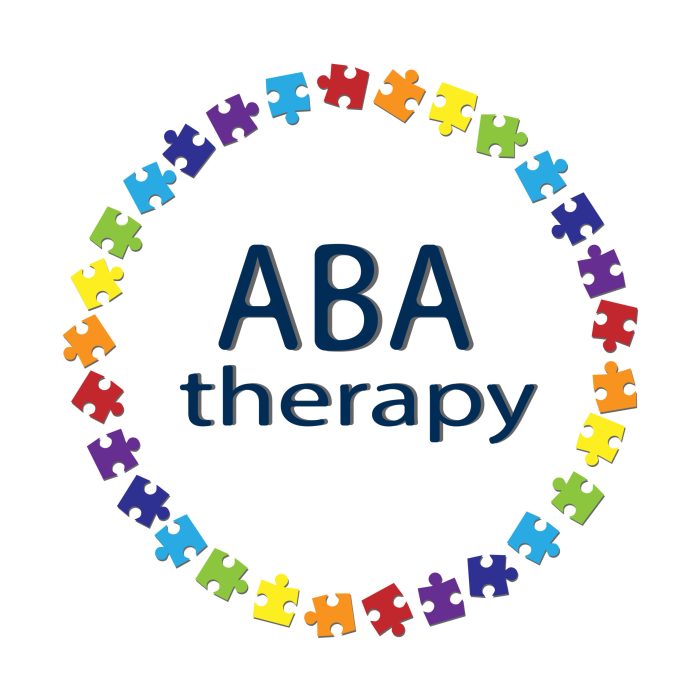An introduction to behavior analysis. – An introduction to behavior analysis opens the door to understanding the complex world of human and animal behavior. This scientific approach delves into the principles that govern our actions, providing valuable insights into how we learn, interact, and shape our environment.
Behavior analysis has a rich history, dating back to the pioneering work of B.F. Skinner and others. Its principles have been successfully applied in diverse fields, including education, therapy, and business, demonstrating its versatility and practical relevance.
Overview of Behavior Analysis

Behavior analysis is the scientific study of behavior, with a focus on how environmental factors influence behavior. It seeks to understand the principles that govern behavior and how these principles can be used to improve behavior and solve problems.
History and Development of Behavior Analysis
The history of behavior analysis can be traced back to the early 20th century, with the work of Ivan Pavlov and John B. Watson. Pavlov’s research on classical conditioning showed that animals could learn to associate stimuli with rewards or punishments, while Watson’s work on operant conditioning showed that animals could learn to associate behaviors with rewards or punishments.
In the 1930s, B.F. Skinner developed a more comprehensive theory of behavior, known as radical behaviorism. Skinner’s theory emphasized the importance of environmental factors in shaping behavior and argued that behavior is not simply a product of internal mental processes.
Behavior analysis has since grown into a major field of study, with applications in a wide range of areas, including education, psychology, and business.
Basic Principles of Behavior Analysis
![]()
Behavior analysis is the scientific study of behavior and its environmental determinants. It is based on the principles of operant conditioning, classical conditioning, and observational learning.
Operant Conditioning
Operant conditioning is a type of learning in which the consequences of a behavior affect the likelihood of that behavior being repeated. Reinforcement is anything that increases the likelihood of a behavior being repeated, while punishment is anything that decreases the likelihood of a behavior being repeated.
- Positive reinforcement:Giving a reward after a desired behavior increases the likelihood of that behavior being repeated.
- Negative reinforcement:Removing an unpleasant stimulus after a desired behavior increases the likelihood of that behavior being repeated.
- Positive punishment:Giving an unpleasant stimulus after an undesired behavior decreases the likelihood of that behavior being repeated.
- Negative punishment:Removing a pleasant stimulus after an undesired behavior decreases the likelihood of that behavior being repeated.
Classical Conditioning
Classical conditioning is a type of learning in which a neutral stimulus becomes associated with a meaningful stimulus, leading to a conditioned response. The neutral stimulus is something that does not initially trigger a response, while the meaningful stimulus is something that does trigger a response.
- Association:The neutral stimulus and the meaningful stimulus are paired together repeatedly.
- Stimulus generalization:The conditioned response can be elicited by stimuli that are similar to the original neutral stimulus.
Observational Learning
Observational learning is a type of learning in which an individual learns by observing the behavior of others. This type of learning is also known as social learning or modeling.
- Attention:The individual must pay attention to the behavior of the model.
- Retention:The individual must remember the behavior of the model.
- Reproduction:The individual must be able to perform the behavior of the model.
- Motivation:The individual must be motivated to perform the behavior of the model.
Applications of Behavior Analysis

Behavior analysis has a wide range of applications in various settings, including education, therapy, and business. By understanding the principles of behavior, professionals can effectively modify and improve behaviors, as well as solve problems and enhance performance.
Education
In educational settings, behavior analysis is used to:
- Improve student engagement and motivation
- Manage challenging behaviors
- Develop effective teaching strategies
- Enhance academic performance
Therapy
In therapeutic settings, behavior analysis is used to:
- Treat a variety of mental health disorders, such as anxiety, depression, and phobias
- Reduce problem behaviors, such as self-injury and aggression
- Improve social skills and communication
- Promote adaptive behaviors, such as self-care and independent living
Business
In business settings, behavior analysis is used to:
- Increase employee productivity and performance
- Improve customer satisfaction
- Reduce workplace accidents and injuries
- Develop effective training programs
Ethical Considerations in Behavior Analysis

Conducting behavior analysis involves ethical considerations to ensure the well-being and rights of individuals. Ethical guidelines provide a framework for researchers and practitioners to follow, ensuring responsible and ethical practices.
Informed consent is paramount in behavior analysis. Participants must be fully informed about the nature of the research or intervention, potential risks and benefits, and their right to withdraw at any time. Confidentiality is crucial to protect participants’ privacy and prevent any harm or discrimination.
Researchers must take measures to safeguard participants’ data and ensure it is used only for legitimate purposes.
Potential Ethical Dilemmas
Ethical dilemmas may arise in behavior analysis, such as:
- Balancing the potential benefits of an intervention against potential risks or discomfort to participants.
- Deciding whether to disclose sensitive information to participants or third parties, considering confidentiality and privacy concerns.
- Addressing conflicts of interest, such as when researchers have financial or personal ties to a particular intervention or outcome.
To address these dilemmas, behavior analysts should:
- Consult with ethics committees or review boards for guidance.
- Engage in ongoing self-reflection and ethical decision-making.
- Prioritize the well-being and rights of participants above all else.
Research Methods in Behavior Analysis: An Introduction To Behavior Analysis.

Research in behavior analysis is essential for understanding the principles of behavior and developing effective interventions. Researchers use various methods to investigate behavior, including single-subject designs and group designs.
Single-Subject Designs
Single-subject designs involve studying the behavior of an individual over time, allowing researchers to observe changes in behavior in response to specific interventions. Common single-subject designs include:
- ABAB Design:Alternates between a baseline phase (A) and an intervention phase (B).
- Multiple Baseline Design:Measures behavior across multiple baselines before introducing an intervention.
- Changing Criterion Design:Gradually changes the criterion for reinforcement to increase the frequency of desired behavior.
Group Designs, An introduction to behavior analysis.
Group designs involve comparing the behavior of two or more groups, allowing researchers to make inferences about the effects of different interventions. Common group designs include:
- Between-Subjects Design:Participants are randomly assigned to different experimental groups.
- Within-Subjects Design:Participants serve as their own controls, experiencing different conditions in a counterbalanced order.
Experimental control is crucial in behavior analysis research to ensure that changes in behavior are due to the intervention rather than other factors. Researchers use control conditions, such as no-treatment groups or placebo groups, to rule out alternative explanations.
Data analysis in behavior analysis involves both descriptive and inferential statistics. Descriptive statistics provide a summary of the data, while inferential statistics allow researchers to make inferences about the population from which the sample was drawn.
Current Trends and Future Directions in Behavior Analysis

Behavior analysis is a rapidly evolving field, with new research and applications emerging all the time. Some of the most exciting current trends include:
Emerging Areas of Research in Behavior Analysis
- Precision medicine:Behavior analysts are working to develop personalized treatments for mental health disorders, based on each individual’s unique genetic and environmental factors.
- Technology:Technology is playing an increasingly important role in behavior analysis, from the development of new assessment and intervention tools to the use of artificial intelligence to analyze data.
- Social justice:Behavior analysts are working to apply their knowledge and skills to address social problems such as poverty, crime, and discrimination.
How Technology is Influencing the Field of Behavior Analysis
Technology is having a major impact on the field of behavior analysis. For example, behavior analysts are now using:
- Virtual reality (VR):VR can be used to create realistic simulations of real-world environments, which can be used to assess and treat a variety of behavioral problems.
- Artificial intelligence (AI):AI can be used to analyze data and identify patterns that would be difficult or impossible for humans to detect. This information can be used to develop more effective interventions.
- Mobile devices:Mobile devices can be used to deliver interventions, collect data, and track progress.
Predictions for the Future of Behavior Analysis
The future of behavior analysis is bright. The field is growing rapidly, and new research and applications are emerging all the time. Here are a few predictions for the future of behavior analysis:
- Behavior analysis will become more personalized.Treatments will be tailored to each individual’s unique needs, based on their genetic and environmental factors.
- Technology will continue to play an increasingly important role in behavior analysis.New technologies will be developed to assess and treat behavioral problems, and to collect and analyze data.
- Behavior analysis will be used to address a wider range of problems.Behavior analysts will work to apply their knowledge and skills to solve social problems such as poverty, crime, and discrimination.
Common Queries
What is the main goal of behavior analysis?
The primary goal of behavior analysis is to understand and modify behavior by identifying the factors that influence it.
How is behavior analysis used in education?
Behavior analysis principles are applied in education to enhance learning outcomes by reinforcing desired behaviors and reducing undesirable ones.
What are the ethical considerations in behavior analysis?
Ethical guidelines in behavior analysis emphasize informed consent, confidentiality, and the avoidance of harm or coercion.